The Benefits of a Multi-Cloud Strategy
Improve economics and performance with a multi-cloud strategy

Businesses of every size and industry are implementing cloud services to reduce infrastructure cost and complexity, and accelerate the pace of innovation. Infrastructure as a Service (IaaS), Platform as a Service (PaaS) and Software as a Service (SaaS) solutions help companies avoid capital equipment outlays and operating expenses, and free up staff to focus on core business activities.
According to a 2020 IDG cloud computing survey of 550 IT decision-makers, 81% of survey respondents reported already using computing infrastructure or have applications in the cloud. Another 12% plan to adopt cloud-based applications in the next 12 months, and 6% plan to do so in the next 1 to 3 years. And more than a third of respondents say their IT organization is under pressure to migrate all applications and infrastructure to the cloud.
Cloud Spending is on the Rise
Businesses around the world are shifting IT budget to the cloud. In the IDG survey, cloud services now represent 32% of IT spending. And in a July 2018 Forrester Consulting survey of 700+ IT decision makers, almost half of enterprise respondents reported spending at least $50 million a year on cloud services. Many enterprises are using public cloud services to accelerate time-to-value and simplify operations. Goldman Sachs forecasts annual global public cloud spending to exceed $115 billion by 2021.


Leveraging Public Clouds
Some businesses are leveraging public cloud services, some are building out their own cloud infrastructure and most are using a combination of both. A 2020 Flexera State of the Cloud Report reveals 96% of businesses are using public clouds, 76% are using private clouds and 74% are using a combination of public and private clouds.
Public Cloud vs Private Cloud vs Hybrid Cloud
You can implement cloud services using a public cloud, private cloud or hybrid cloud approach.
Public Cloud A shared, remotely hosted and managed, multi-tenant IT environment. Amazon Web Services (AWS), Microsoft Azure and Google Cloud Platform (GCP) are some of the most popular first-generation public clouds. Wasabi is also a public cloud, specifically, a next-generation IaaS storage solution.
Private Cloud A cloud implementation dedicated to a single tenant, typically done by using virtualization technology. Some businesses implement and manage their own clouds in a corporate data center or co-location center. Private clouds are typically operated by corporate IT and used by line-of-business customers to build and run applications. Managed service providers, colocation providers and some public cloud providers also offer private cloud services, i.e. a remotely hosted and managed cloud instance, running on hardware dedicated to a single customer.
Hybrid Cloud A mixed implementation composed of public and private cloud resources. For example, a business might use a private cloud for workloads with extreme security or performance requirements, and a public cloud for workloads with less stringent requirements.
Multi-Cloud Strategies Improve Economics and Performance
Most businesses are embracing multi-cloud strategies–using multiple public and/or private clouds to avoid lock-in, minimize expenses and optimize performance. In the RightScale survey, 93% of enterprises have a multi-cloud strategy, while 7% plan to use a single public or private cloud. Today, the average company in the survey already uses five different clouds—three for production applications and two for experimentation.
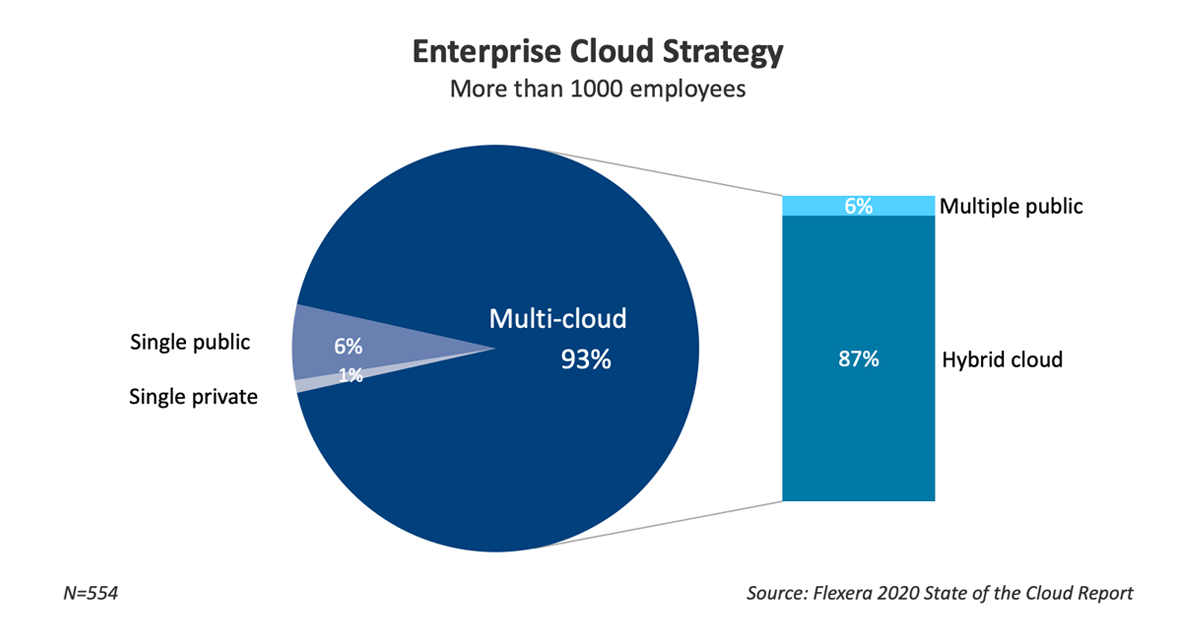
Greater choice
You can use multiple providers to avoid lock-in and improve vendor leverage.
Best-of-breed functionality
You can pick the cloud provider that specializes in a particular set of services e.g. object storage, content delivery, bare-metal compute.
Optimal price and performance
You can pick the cloud that offers the best pricing or performance in a particular geography or for a particular set of capabilities.
Improved resiliency
You can run applications or store data on multiple clouds to ensure continuous availability in the event of a service outage.
Global compliance
You can use a mix of clouds to comply with varying government regulations across geographies.
Gartner: Approaches to Hybrid Cloud Storage
- “TCO reduction remains the primary goal for hybrid cloud storage implementations. However, this has been difficult to achieve due to several hidden costs.”
- “Most enterprise usage of on-premises and public cloud storage resources are in isolation of each other because useful ways of tying the two together have not existed until recently.”
- “The limited network bandwidth between enterprise data centers and cloud IaaS providers inhibits the use of hybrid cloud storage for large datasets.”

Greater Choice
While first-generation public cloud providers like to talk about open APIs and digital marketplaces, the fact of the matter is most are closed systems. Legacy providers like AWS lock-in customers by charging excessive transfer fees to move data out of their cloud. These walled gardens stifle innovation and limit choice. Many early adopters who migrated to the cloud to escape proprietary hardware and software vendors now find themselves held hostage to Amazon.
Many businesses are looking for greater choice and are pursuing multi-cloud options using more open-minded and forward-looking cloud providers. Industry peering associations like the Bandwidth Alliance encourage multi-cloud implementations by allowing customers to move data between providers with nominal or no transfer fees.

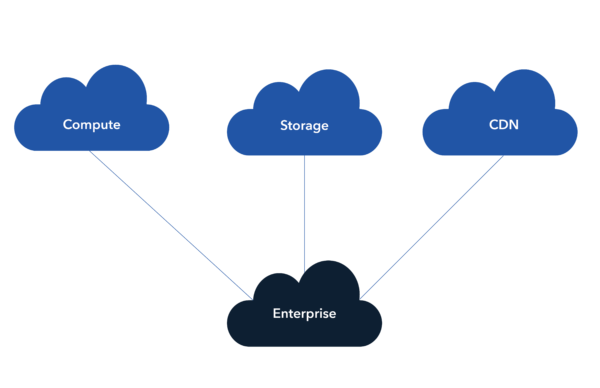
A Best-of-Breed Multi-Cloud Implementation with Specialized Compute, Storage and Content Delivery Network (CDN) Providers
Best of Breed Functionality
Most legacy public cloud providers offer bloated portfolios of compute, storage and networking services. AWS, Microsoft Azure and Google Cloud Platform all sell dozens of different products from blockchain applications, to machine learning solutions to security tools. With so many different products to support and enhance, it is difficult for legacy providers to maintain expertise and leadership across their entire product line. (They’ve become a jack of all trades, master of none.)
Many enterprises are shying away from single-vendor implementations and instead leveraging different cloud providers for different applications or functions. In the Forrester study, 32% of respondents said they were using multiple clouds to support different workloads. By leveraging a variety of specialized providers, you can partner with experts, keep pace with the latest advances in technology and gain a leg up on the competition.
DCIG: Best Practices for Performing Cloud-to-Cloud Data Migrations
Roughly 85% of companies already store some data with cloud providers or plan to do so in the very near future. No one disputes that point. It is the cloud’s cost and complexity that has a growing number of these same organizations wringing their hands. While they love the cloud’s benefits, they hoped to lower their costs and simplify IT as they adopted it. Instead, they often experience the opposite—more costs and complexity.
Trying to remedy this situation using their existing cloud provider’s solutions puts them between a rock and a hard place.


Cost or Performance Optimization
Many companies are using multiple cloud providers to balance costs or performance. Cloud pricing, performance and service level commitments can vary widely from region to region. Many multinational businesses leverage a mix of cloud providers to optimize application performance and minimize operating expenses across the globe.
The latest multi-cloud data controllers and management platforms let you automatically orchestrate workloads and distribute data across clouds based on administratively defined policies. They help you contain costs and accelerate performance by intelligently selecting the best cloud for a particular application.
Improved Resiliency
Some businesses are using multiple cloud providers for redundancy, leveraging one cloud as a primary provider and a second cloud as a hot standby for business continuity and disaster recovery. By replicating workloads or data across clouds you can ensure continuous service in the event of a major service outage or denial of service attack.
Most cloud providers offer secondary data centers for high availability, but you can improve resiliency and mitigate system-wide failures by using a second cloud provider for redundancy. The diagram below shows how you can use two different storage clouds to improve data availability. You can architect your applications to write data to both clouds. If the primary storage cloud is unreachable, applications can fail over to the hot-standby storage cloud.

Wasabi for Multi-Cloud Strategies
Wasabi hot cloud storage is extremely economical, fast and reliable cloud object storage for any purpose. Unlike first-generation cloud storage services with confusing storage tiers and complex pricing schemes, Wasabi is easy to understand and cost-effective to scale. One product, with predictable and straightforward pricing, supports virtually every cloud storage use case, making Wasabi a perfect fit for a multi-cloud implementation.
Wasabi’s key advantages for multi-cloud strategies include:
Commodity pricing
Wasabi hot cloud storage costs a flat $.0059/GB/month. Compare that to $.023/GB/month for Amazon S3 Standard, $.026/GB/month for Google Multi-Regional and $.046/GB/month for Azure RA-GRS Hot.
Unlike AWS, Google Cloud Platform and Azure we don’t impose extra fees to retrieve data from storage (egress fees). And we don’t charge extra fees for PUT, GET, DELETE or other API calls.
Read our New Economics of Cloud Storage tech brief
Superior performance
Wasabi’s parallelized system architecture delivers faster read/write performances than first-generation cloud-storage services, with significantly faster time-to-first-byte speeds.
Download our Performance Benchmark report
Robust data durability and protection
Wasabi hot cloud storage is engineered to deliver extreme data durability, integrity and security. An optional data immutability capability prevents accidental deletions and administrative mishaps; protects against malware, bugs and viruses; and improves regulatory compliance.
Read our Strong Security tech brief
Read our Data Immutability tech brief
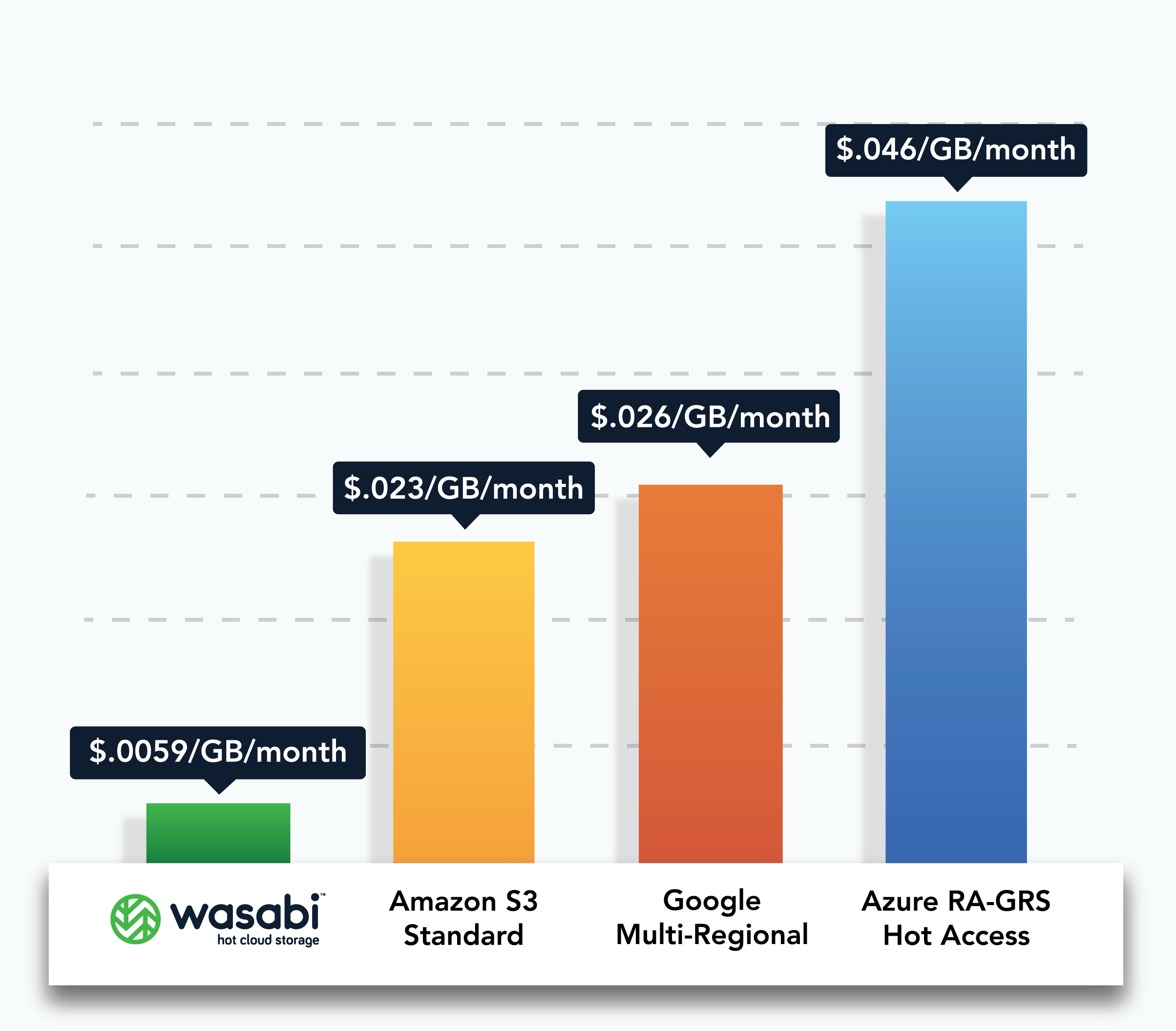
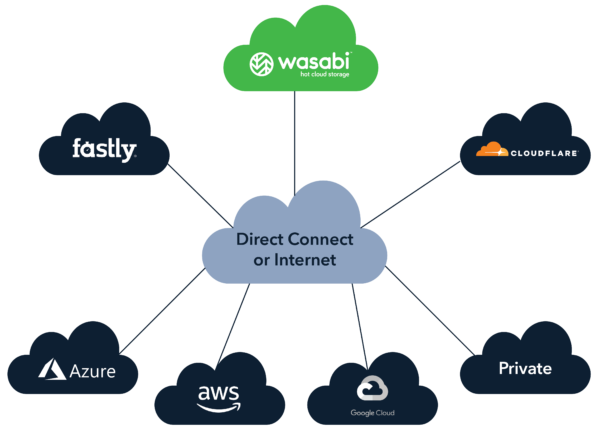
Wasabi in a Multi-Cloud Environment – No Fees to Transfer Data out of Wasabi
Greater Choice
You can use Wasabi hot cloud storage as part of a multi-cloud implementation to improve choice and avoid vendor lock-in. Wasabi offers direct private or public network connectivity to AWS, Microsoft Azure, Google Cloud Platform and other popular IaaS and PaaS platforms through partnerships with leading colocation, carrier hotel and exchange providers like Equinix, Flexential and Limelight Networks. These private network connections avoid internet latency and bottlenecks, providing fast and predictable performance. You can also connect your private enterprise network or private cloud directly to Wasabi.
Unlike with legacy providers, with Wasabi Direct Connect you never pay extra transfer (egress) fees to move data out of Wasabi. You can also connect to Wasabi over the public internet, with no egress or API fees.
Wasabi also maintains partnerships and peering relationships with leading CDN providers like Cloudflare and Fastly, so you can use Wasabi hot cloud storage as an origin server in a content delivery network.
Best of Breed Functionality
Unlike general-purpose IaaS and PaaS providers, Wasabi is 100% focused on cloud storage. Extremely fast, affordable and reliable, you can use Wasabi hot cloud storage for a wide range of storage applications.
In a multi-cloud implementation you can use Wasabi as primary storage for first-generation compute services like AWS EC2, Azure Compute and Google Compute Engine. You can run your workloads on the compute clouds that best meet your price and functional requirements, and store your data on Wasabi to save money and boost performance.
You can also use Wasabi as primary storage for next-generation cloud compute services like Equinix Metal. Many Wasabi customers use next-gen compute platforms to supplement or replace traditional cloud compute services like AWS EC2.
Some customers use conventional first-generation IaaS and PaaS solutions for development, prototype and test, and use next-generation platforms for production workloads to reach their scalability needs with the best possible price and performance characteristics. Others use next-gen platforms like Equinix Metal throughout the entire application lifecycle from prototype to production.
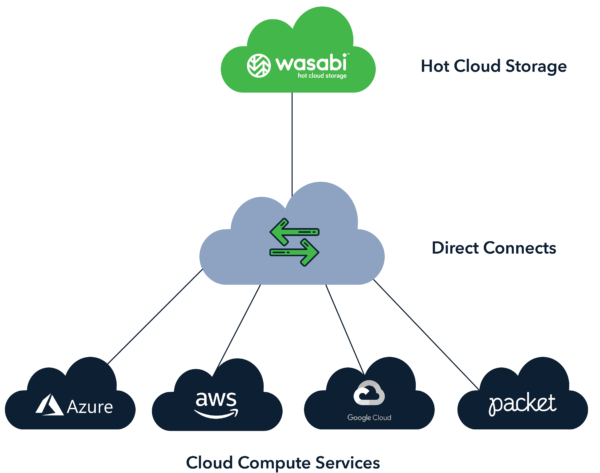
Wasabi for Primary Storage for Cloud Compute Workloads
Cost or Performance Optimization
You can use Wasabi in conjunction with other cloud storage services to optimize costs or performance. Contemporary multi-cloud controllers and data management platforms let you seamlessly move and distribute data between and across storage clouds based on policy.
For example, using a multi-cloud data controller like Scality Zenko you can automatically place data on a particular storage cloud for a particular application or workload based on business rules. You can choose a primary storage target for a specific workload based on storage cloud price or performance metrics. You can also use a multi-cloud controller to replicate data across multiple storage clouds for high availability, or to backup data to a secondary cloud for disaster recovery.
Distribute Data Across Storage Clouds Based on Policy using Scality Zenko
And with third-party virtual storage fabric controllers like NooBaa (now part of Red Hat) you can distribute data across clouds and on-site storage, based on policy, helping you protect and extend on-premises investments.
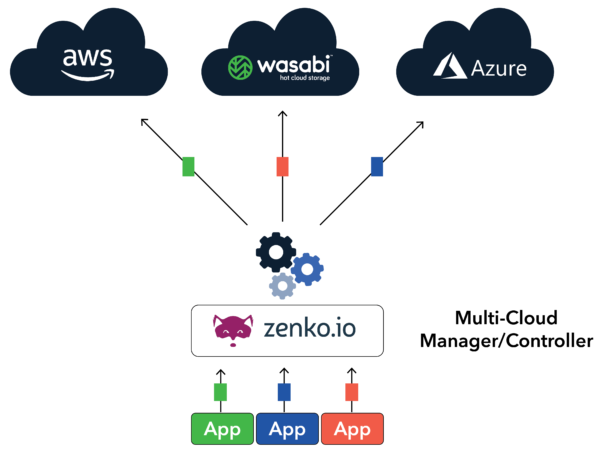
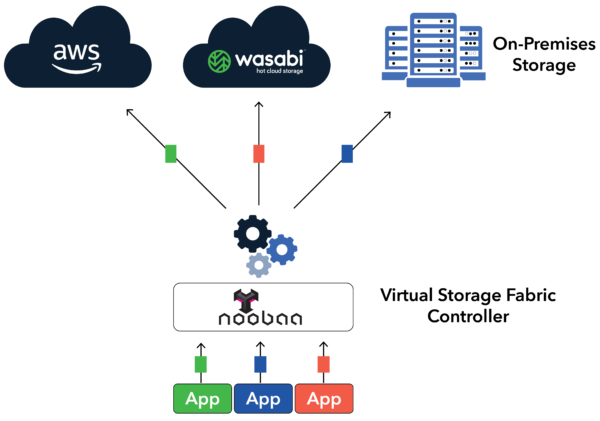
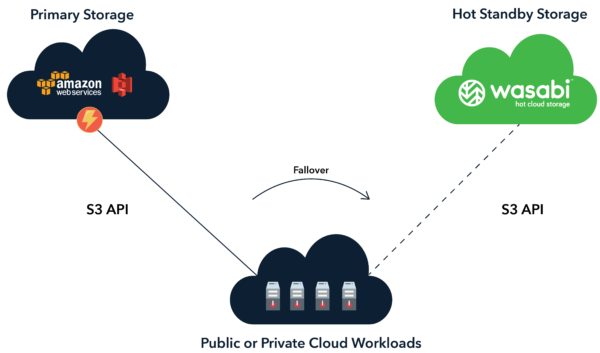
Improved Resiliency for Amazon S3
You can use Wasabi as a cost-effective hot standby in an Amazon S3 storage implementation. Wasabi hot cloud storage is an affordable alternative to Amazon S3 Cross-Region Replication (CRR). You can keep a live copy of your S3 data on Wasabi for the fraction of the price of a secondary S3 region, and for that matter, replicate in two or more Wasabi regions at a lower cost than staying within the AWS ecosystem. If the S3 service is unavailable your applications can failover to Wasabi.
You can also replicate data to an immutable Wasabi bucket to protect data against administrative mishaps, accidental deletions and ransomware. An immutable data object cannot be deleted or modified by anyone, including Wasabi.
Wasabi as an S3 Hot Standby with Immutable Storage

Global Compliance
Some multinational companies use multiple clouds to satisfy diverse regulatory requirements across the globe. Data privacy and data retention regulations vary from region to region. Take the financial services industry for example. In the United States, the Securities and Exchange Commission (SEC), Financial Industry Regulatory Authority (FINRA) and Commodity Futures Trading Commission (CFTC) impose one set rules for protecting and preserving electronic records. While in the European Union, the Markets in Financial Instruments Directive (MiFID) and General Data Protection Regulation (GDPR) mandates dictate a different set of rules. A global financial services firm may need to use a combination of private and public clouds to ensure worldwide compliance.
Compliance White Papers
Contact Sales
What if you could store ALL of your data in the cloud affordably?
NOW YOU CAN. Wasabi is here to guide you through your migration to the enterprise cloud and to work with you to determine which cloud storage strategy is right for your organization.